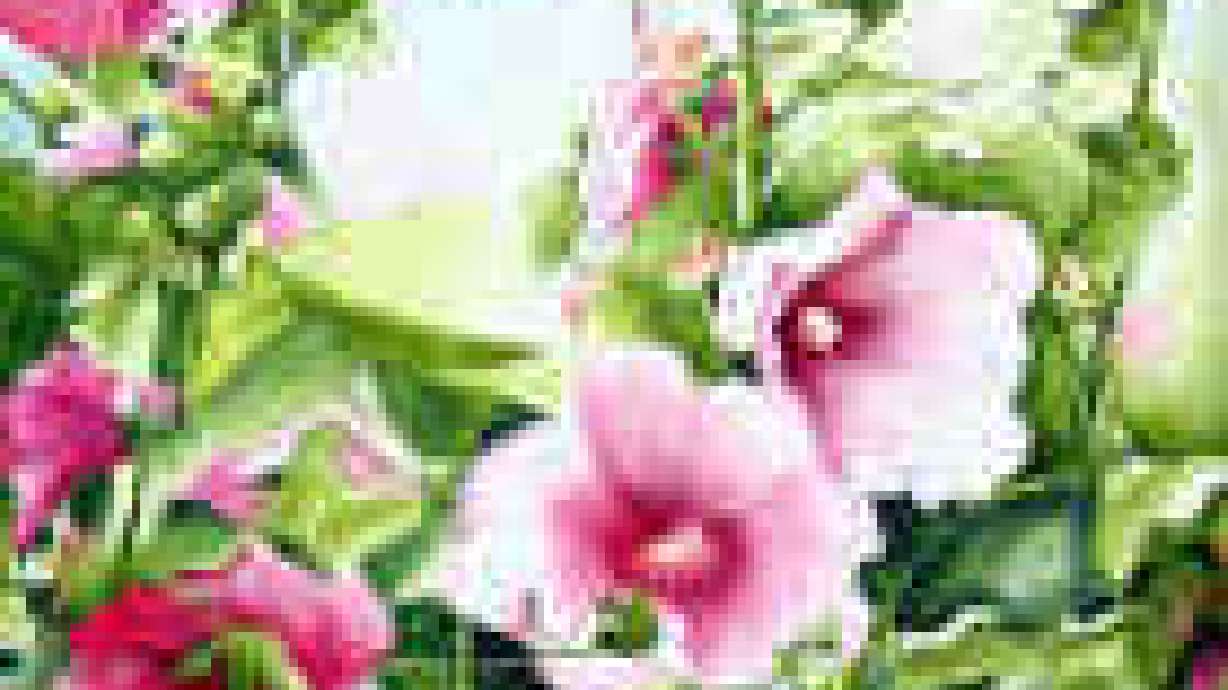Estimated read time: 5-6 minutes
This archived news story is available only for your personal, non-commercial use. Information in the story may be outdated or superseded by additional information. Reading or replaying the story in its archived form does not constitute a republication of the story.
As you continue your flower garden quest with iris from last week, add hollyhocks as another choice. Once again, these are easy-to-grow plants that are old favorites and are getting new attention as gardening trends evolve.
The resurgence in hollyhock popularity comes from several factors. Renewed interest cottage gardens, a desire for drought and heat tolerance in garden flowers and the introduction of many new varieties are all helping fuel their new popularity.
The old-fashioned hollyhocks we know likely came from Western Asia where they thrived on rocky sites and in dry grassy wastelands. For their size and flower displays, they are drought tolerant although they bloom better in moist soils.
I suspect many of your grandmothers had gardens like my grandmothers. They needed easy to care for flowers that did not require purchasing new plants each year and hollyhocks were popular choices. My memories of the tallest flowers in their gardens were the bottoms up view of the colorful spires of funnel-shaped flowers rising above huge clusters of leaves.
As the hollyhocks bloomed in their gardens, they were far more than just showy flowers. To the delight of granddaughters everywhere, these flowers made delightful hollyhock dolls using one blossom as the skirt and another for the bonnet.
The scientific name of the hollyhock is Alcea rosea, making it a member of the Malvaceae family which includes hibiscus, okra, lavatera and even cotton. All have funnel-shaped flowers and the older varieties have five petals with large floral parts in the center. Many new cultivars have double flowers.
The botanical classification is simple but the growing habit is not. Many books classify hollyhocks as perennials. In truth, most are biennials that appear to be perennials because their seeds germinate and grow in the same place.
A few hollyhocks are annuals that germinate and flower the first year from seed. During the first year, flowering is sparse, but the second year they show their glorious flowers from May until August.
Several perennial hollyhocks are available. Although these plants may live and flower for several years, these rarely flower as much as new plants started from seed. Fortunately, the seeds are easy to start and grow so you never need to be without these plants in your garden.
The plants are hardy form Zone 3 thru 8 so they thrive in all areas of Utah. They also are heat tolerant and bloom during the hottest part of the summer. Plant them where they are in full sun, as the plant dislikes shade of any kind.
The rainbow has serious competition from these lovely plants. The range starts with white and goes almost to true black. In between are pinks, reds, purples, yellows, coral and almost any other color except true blues.
The height range is just as amazing. Some of the newer dwarfs grow less than two feet high while some of the old-fashioned varieties will grow to nine feet or more in height. That makes them perfect background flowers in borders, along fences or walls.
The easiest way to establish hollyhocks is from seeds. All of the old-fashioned varieties produce viable seed that you can collect in the fall and plant in your garden or share with friends. Seeds germinate in 2-3 weeks at 60°F.
Try spring sowing or plant in August to produce flowering plants next year. If you have the right growing area, start seeds started indoors as bedding plants for bloom the following summer. Right now, look for them as plants in local nurseries.
Hollyhocks do best in moist, well-drained areas. They prefer a rich soil with abundant organic matter and in rural areas often bloom profusely in old, moist manure piles. Add fertilizer as needed in early spring to help the plants flourish.
Now that I have extolled their virtues, truth in journalism requires I bring up of the downsides of hollyhock growing. Like most plants, they do have a few insect and disease problems.
Hollyhock rust is the most common disease in Utah. The rust fungus first appears on the undersides of lower leaves as yellow to orange pustules that darken with age. Later the top of the leaf shows bright orange spots with red centers that may finally destroy large parts of the leaf.
Use good sanitation to control rust. Pick off infected leaves in the spring and destroy them. When plants stop flowering, cut them back to the base. Provide good air circulation and avoiding overhead watering to reduce the severity of the disease. Some varieties are rust resistant.
If sanitation does not control the disease, apply a fungicide such as chlorothalonil (Daconil), sulfur or copper in the spring as new growth starts. Several sprays may be necessary to keep new leaves protected against infection.
If your hollyhock leaves have holes chewed through their leaves, the pest is the hollyhock weevil. This small beetle eats holes in flower buds and seeds. The female weevil uses her long snout to chew holes in flower buds to lay eggs. The grub stage also feeds on the developing seeds. Apply insecticides as needed to control this pest.
Spider mites, caterpillars, slugs and snails also plague hollyhocks. Use insecticidal soap, Bt and baits respectfully to help reduce these pests to manageable levels.
In spite of your best efforts, pests often make the leaves unattractive even though the flowers still look good. Sometimes the best options include planting hollyhocks far enough away so you cannot see the leaves, or planting something in front of your hollyhocks to hide the leaves.








